Chapter 10 - Professor: Gianinnas PDF

| Title | Chapter 10 - Professor: Gianinnas |
|---|---|
| Author | Nicole DiLeva |
| Course | (Uc) Elements Of Physics |
| Institution | Quinnipiac University |
| Pages | 4 |
| File Size | 74.3 KB |
| File Type | |
| Total Downloads | 1 |
| Total Views | 146 |
Summary
Professor: Gianinnas...
Description
2/6/19 Projectile Motion ● Without gravity, a tossed object follows a straight-line path ● With gravity, the same object tossed at an angle follows a curved path ● Projectile: ○ Any object that moves through the air space under the influence of gravity, continuing in motion by its own inertia ● Projectile motion is a combination of a horizontal component and a vertical component. ○ Both acts independently from each other ● Projectile launched horizontally… ● Horizontal component of velocity doesn’t change (when air drag is negligible). ○ Ball travels the same horizontal distance in equal times (no component of gravitational force acting horizontally) ○ Remains constant. ● Projectile launched vertically… ● Vertical positions become further apart with time. ○ Gravity acts downwards, so ball accelerates downward. ● Curvature of path is the combination of horizontal and vertical components of motion. ● Parabola ○ Curved path of a projectile that undergoes acceleration only in the vertical direction, while moving horizontally at a constant speed. ○ Bullet fired vs. bullet dropped = same time hit the ground ● Projectiles launched at an angle… ○ Path of stone thrown at an angle upward and downward ■ Vertical and horizontal components are independent of each other. ■ Horizontal is always the same ● Paths of a cannonball shot at an upward angle ○ Vertical distance that a stone falls is the same vertical distance it would have fallen if it had been dropped from rest and been falling for the same amount of time. ● Paths of projectile following a parabolic trajectory ○ Horizontal component along trajectory remains unchanged. ○ Only vertical component changes. ○ Velocity at any point is computed with the Pythagorean Theorem. ■ Changes in magnitude ■ Changes in direction ● Different horizontal distances ○ Same range is obtained from two different launching angles when the angles add up to 90 degrees (complementary angles)
■ Object thrown at an angle of 60 degree has the same range as if it were thrown at an angle of 30 degrees ■ 15 degrees and 75 degrees ● 45 degrees will always give you the greatest range. ○ With air resistance … the maximum range of a baseball batted at less than 45 degrees above the horizontal (~25 - 34 degrees). ○ With air resistance … the maximum range occurs when a golf ball is hit at an angle less than 38 degrees. ● Without air resistance, the time for a projectile to reach its maximum height is the same as the time for it to return to its initial level. Fast-Moving Projectiles - Satellites ● Satellite motion is an example of a high-speed projectile ● A satellite is simply a projectile that falls around Earth rather than into it ○ Sufficient tangential velocity needed for orbit Circular Satellite Orbits ● Speed ○ Must be great enough to ensure that its falling distance matches Earth’s curvature ○ Constant - only direction changes ○ Unchanged by gravity ● Positioning ○ Beyond Earth’s atmosphere, where air resistance is almost totally absent ○ Ex: Space shuttles are launched to altitude of 150 km to be above air drag ● Motion ○ Moves in direction perpendicular to the force of gravity acting on it ● Period for complete orbit about Earth ○ For satellites close to Earth, about 90 minutes ○ For satellites at higher altitudes, longer periods ● Curvature of Earth ○ Earth surface drops a vertical distance of 5m for every 8000m (8 km) tangent to the surface Elliptical Orbit ● A projectile just above the atmosphere will follow an elliptical path if given a horizontal speed greater than 8 km/s ● Ellipse ○ Specific curve, an oval path ○ Example: A circle is a special case of an ellipse when its two foci coincide ● Elliptical Orbit
● Speed of satellite varies ○ Initially, if speed is greater than needed for circular orbit, satellite overshoots a circular path and moves away from Earth ○ Satellite loses speed and then regains it as it falls back toward Earth ○ It rejoins its original path with the same speed it had initially ○ Procedure is repeated Kepler’s Law of Planetary Motion ● Found that the motion of the planets was not circular; rather, it was elliptical ● Kinematic laws- how things move and how they need to move based on observations, but did not explain WHY they moved this way (dynamics) ● 1st Law ○ The path of each planet around the Sun is an ellipse with the Sun at one focus. ● 2nd Law ○ The line from the Sun to any planet sweeps out equal areas of space in equal time intervals. ● 3rd Law ○ The square of the orbital period of a planet is directly proportional to the cube of the average distance of the planet from the Sun (for all planets). Energy Conservation and Satellite Motion ● Recall following: ○ Object in motion possesses KE due to its motion ○ Object above Earth's surface possesses PE by virtue of its position ○ Satellite in orbit possesses KE and PE ■ Sum of KE and PE is constant at all points ● PE, KE, and speed in circular orbit ○ Unchanged ○ Distance between the satellite and center of the attracting body does not change- PE is same everywhere ○ No component of force acts along the direction of motion- no change in speed and KE ● Elliptical Orbit Varies. ○ PE is greatest when the satellite is farthest away (apogee). ○ PE is least when the satellite is closest (perigee). ○ KE is least when PE is most and vice versa ○ At every point in the orbit, sum of KE and PE is the same *drawing in notebook* ● When a satellite gains altitude and moves against the gravitational force, its speed and KE decrease and decrease continues to the apogee ● Past the apogee, satellite moves in the same direction as the force component and
speed and KE increase. Increase continues until the perigee and cycle repeats
Escape Speed ● First probe to escape the solar system was Pioneer 10, launched from Earth in 1972 ● Voyages to the Moon, Mars, and beyond begin with launched that exceed escape speed from Earth QUESTIONS/REVIEW ● Assuming no air resistance, the horizontal component along the path of the projectile remains the same. ● When no air resistance acts on a fast moving baseball, its acceleration is downward, g. (the horizontal motion is constant - there is no acceleration in that. The acceleration is in the gravity - downward) ● As the ball leaves the girl’s hand, 1 s later it will have fallen 5 meters below the dashed line. ( d = ½ (10 m/s2) (1s)2) ● When a satellite travels at a constant speed, the shape of its oath is a circle. ● The speed of a satellite in an elliptical orbit varies...
Similar Free PDFs

Lecture 10 - Professor Pickering
- 6 Pages

Chapter 4 - Professor Trone
- 4 Pages

Chapter 10 quiz #10
- 3 Pages

Notes 10 - Chapter 10
- 5 Pages
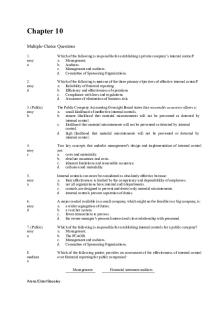
Chapter-10
- 19 Pages
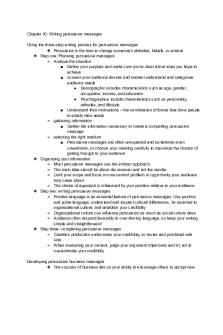
Chapter 10
- 5 Pages
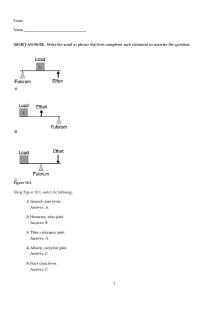
Chapter 10
- 14 Pages

Chapter 10
- 111 Pages
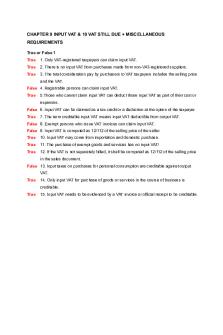
Chapter 10
- 16 Pages
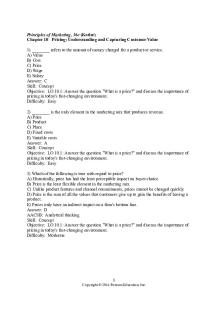
Chapter 10
- 47 Pages
Popular Institutions
- Tinajero National High School - Annex
- Politeknik Caltex Riau
- Yokohama City University
- SGT University
- University of Al-Qadisiyah
- Divine Word College of Vigan
- Techniek College Rotterdam
- Universidade de Santiago
- Universiti Teknologi MARA Cawangan Johor Kampus Pasir Gudang
- Poltekkes Kemenkes Yogyakarta
- Baguio City National High School
- Colegio san marcos
- preparatoria uno
- Centro de Bachillerato Tecnológico Industrial y de Servicios No. 107
- Dalian Maritime University
- Quang Trung Secondary School
- Colegio Tecnológico en Informática
- Corporación Regional de Educación Superior
- Grupo CEDVA
- Dar Al Uloom University
- Centro de Estudios Preuniversitarios de la Universidad Nacional de Ingeniería
- 上智大学
- Aakash International School, Nuna Majara
- San Felipe Neri Catholic School
- Kang Chiao International School - New Taipei City
- Misamis Occidental National High School
- Institución Educativa Escuela Normal Juan Ladrilleros
- Kolehiyo ng Pantukan
- Batanes State College
- Instituto Continental
- Sekolah Menengah Kejuruan Kesehatan Kaltara (Tarakan)
- Colegio de La Inmaculada Concepcion - Cebu





